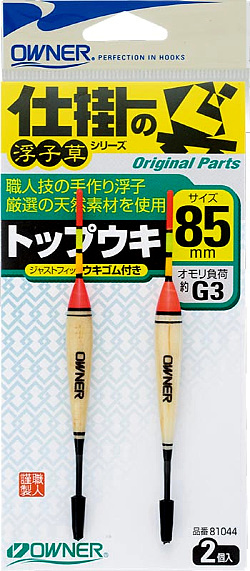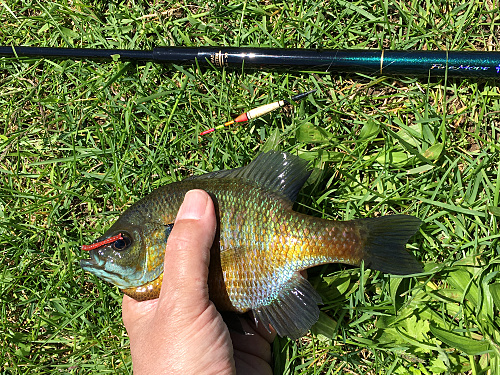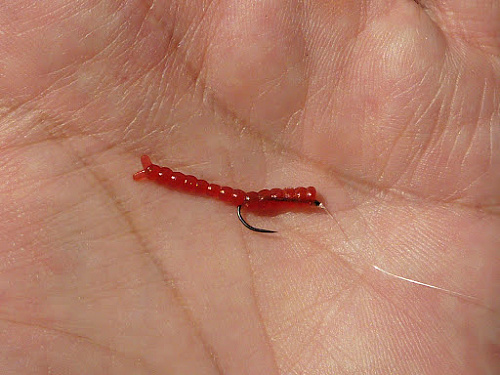Trip Report - 5-11-19
Owner Top Float Bluegills
It's not that I haven't fished since January, it's just that the outings weren't worth writing up - plus there was a tremendous amount of behind-the-scenes work getting ready to switch over from PayPal buttons to a Shopify store, which left very little time for writing.
A couple weeks ago I took a day to do something I had wanted to do for quite some time. Ever since I had gotten in the Owner Top Floats I had wanted to try them in a pond for some bluegills.
Although I had used floats for bluegills before (Trip Report 11-3-13 and Porcupine Quill Floats), the floats I had used left a lot to be desired. I have since stopped carrying the Unibobbers used in the 11-3-13 trip report. They were hard to adjust once attached to the line. The 3/8" Nakazima Floats serve the same purpose and are easy to adjust.
What I had wanted with the porcupine quill was a float that would take only the very slightest pull to go under. The porcupine quills I used were from American porcupines, not the African porcupines that have very large quills.
Used as floats, the American quills were actually too sensitive. They were hard to set correctly. For all but the largest quills, even one size 10 shot was too much weight, and for some of the largest quills, it wasn't quite enough so they floated horizontally rather than standing up as intended.

The Owner Top Floats solve that problem. The ones I used on the 11th were the smallest, 70mm size, and I found that three of the size 6 Dinsmore shot would cock them correctly (with the hook and bait I was using). The body of the float is just large enough to support a hook and small bait.
The stem extending from the bottom of the body slides into a short rubber tube, through which you would have run your line. That traps the line and keeps the hook at a set distance below the float, but it is very easy to pull the stem out of the tubing, slide the tubing up or down the line and reinsert the stem.
Add just enough weight so that only the bristle extending from the top of the body is above the surface. Because the entire float except for that little bit of bristle is already under water, a fish only has to pull hard enough to pull that tiny bit of bristle under. Plus, the long, thin shape of the float provides very little resistance to being pulled through the water, so the fish has little indication that anything is wrong.
Contrast that with the bobbers that many people use. There were a couple guys at one of the ponds we went to who were also fishing with floats. Theirs, though were about the size of ping pong balls. It would take quite a pull to take them under. Even the most insensitive fish would realize something wasn't right and many would drop the bait at the first hint of resistance. A pull that would take an Owner Top Float down decisively would barely cause a big round bobber to jiggle - possibly not enough for the guy on shore to even notice it.
You want a float to do two things: keep your hook at a certain depth and indicate strikes. Keeping your hook off the bottom is the easy part. Indicating strikes is trickier. You absolutely want to know the fish is there before it knows you're there! If your float barely moves when a fish takes your hook, and provides a lot of resistance to being pulled under, it fails the second requirement!
 A Nissin Fine Mode Nagare, Owner Top Float and Eurotackle Original Bloodworm is a great combination for pond bluegills.
A Nissin Fine Mode Nagare, Owner Top Float and Eurotackle Original Bloodworm is a great combination for pond bluegills.On the 11th, I used a Nissin Fine Mode Nagare 2-Way 540. It is a long, soft seiryu rod and is just about ideal for modest sized bluegills. It would also be fine for modest trout up to 10-12", but a 12 incher would be a handful! For lobbing the Owner Top Float out into the pond it worked beautifully. A large bluegill or a very modest bass puts up a huge fight on the soft rod.

Bluegills are notorious bait stealers (mostly because people use bait that is too large for a sunfish to take completely into its mouth, and a bobber that is too large for it to take under). For this trip I didn't use live bait. Instead I used some Eurotackle Original Bloodworms. They are only an inch long and a bluegill can take them easily in one bite. With half the bloodworm threaded onto a Wide Eyed Hook or Gamakatsu R-10B, and the back half free to wiggle enticingly, I rarely had to wait long for a hit, and when a fish took the bloodworm, the float just disappeared. There was no question that a fish had the hook, and there was no need to hesitate at all before tightening the line to hook the fish. For that matter, half of the bloodworm is small enough for the larger micros, such as chubs and shiners.
I think the 11th may have been my first "many" day for the year, but it more than made up for the wait. As Coach says, "It's all about the wiggle" and a mess of bluegills gives you about all the wiggle you could want.
TenkaraBum Home > Trip Reports > Trip Report 5-11-19
“The bitterness of poor quality remains long after the sweetness of low price is forgotten” - Benjamin Franklin
"Be sure in casting, that your fly fall first into the water, for if the line fall first, it scares or frightens the fish..." -
Col. Robert Venables 1662
As age slows my pace, I will become more like the heron.
Warning:
The hooks are sharp.
The coffee's hot.
The fish are slippery when wet.
Beware of the Dogma


